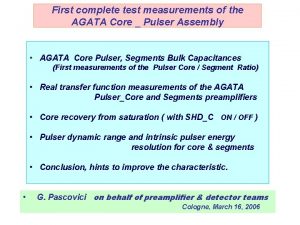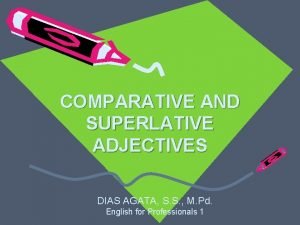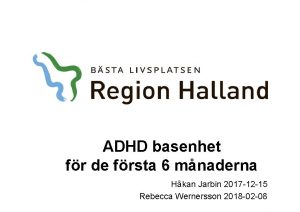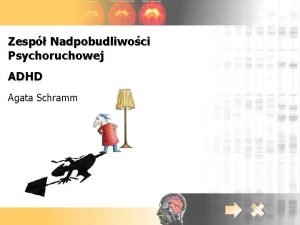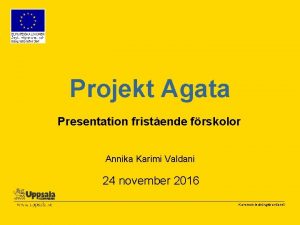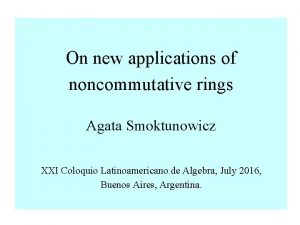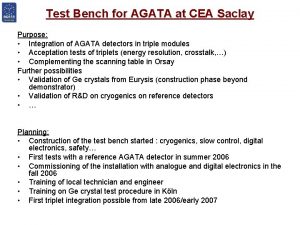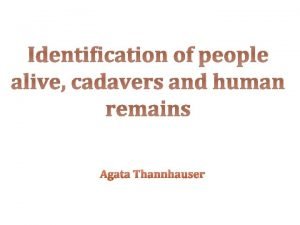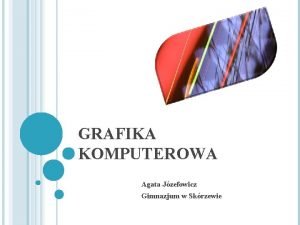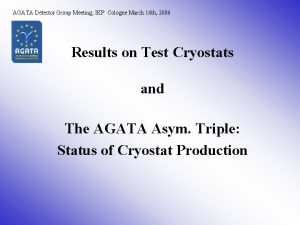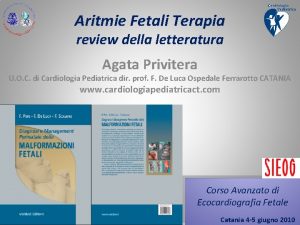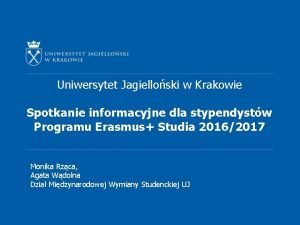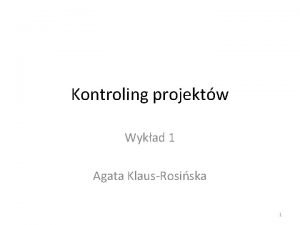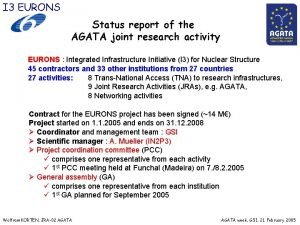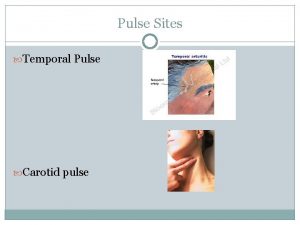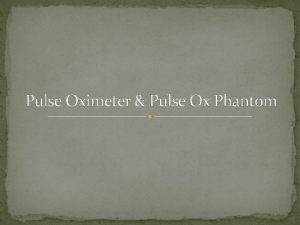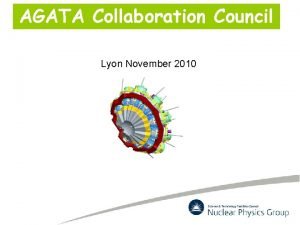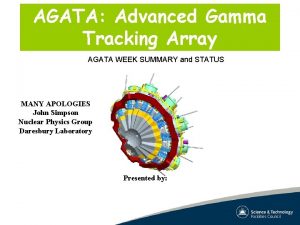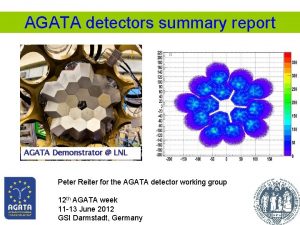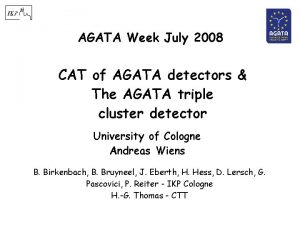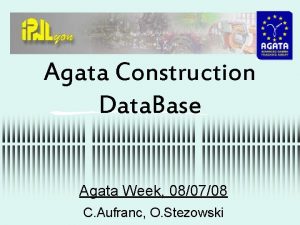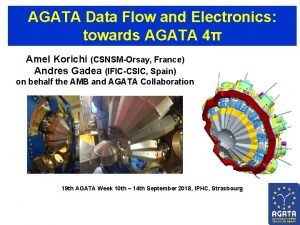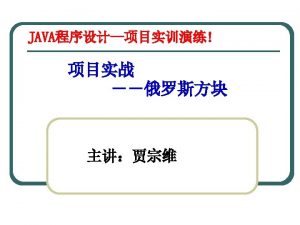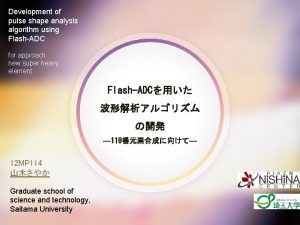AGATA Pulse Shape Analysis Implementation Status Performance Opportunities




































- Slides: 36

AGATA Pulse Shape Analysis Implementation • Status • Performance • Opportunities Dr Andy Boston ajboston@liverpool. ac. uk The AGATA PSA team

AGATA PSA Implementation • Architecture • Algorithms • Implementation – ADL – Experimental basis • Performance

PSA ARCHITECTURE 3

Structure of Data Processing • Local level processing – AGATA Front end electronics • Readout • Pre-processing • PSA – Ancillaries VME+AGAVA FEE RO RO PP PP GTS PP PP • Readout • Pre-processing • Global Level processing – – – Event builder Event merger Pre-processing Tracking Post-Processing Ch. Theisen

Structure of Data Processing Ancillary 1 R 1 G 1 B …. Digitizer or raw data file VME or raw data file Crystal. Producer Event. Builder Ancillary. Producer Preprocessing. Filter Event. Merger Ancillary. Filter PSAFilter Tracking. Filter Consumer Save PSA output Consumer Save tracked output

Preprocesssing Filter • Performs – Energy calibrations and x. Talk (proportional) correction – Analysis of traces • Calculation of T 0 from core (Digital CFD or linear fit of the first samples) • Time calibrations and shifts • Vertical normalization of traces • Define the net-charge segments – Reformats the data • The calibration files are produced by external programs as part of the calibration procedures

PSA Filter • Signal decomposition & diff xtalk • Implemented algorithm is the Grid Search – As a full grid search – As a coarse/fine search (AGS) • Reduces size of data by factor 20 • Provides the parameters for the correction of neutron damage (can also perform it) • Must be expanded to improve timing • Takes ~95 % of total CPU time • Is the critical point for the processing speed of online and offline analyses

PSA ALGORITHMS 8

Position resolution (mm FWHM) Pulse Shape Analysis algorithms Singular Value Decomposition 8 Adaptive Grid Search Artificial Neural Networks 6 Particle Swarm Optimization Genetic algorithm 4 now Wavelet method Least square methods 2 0 Adaptive Grid Search (with final LS-fit refinements) ms Full Grid Search s hr Computation Time/event/detector

AGATA PSA Codes • Typical PSA scheme consists of 3 components • Figure of Merit (FOM) e. g. Σ |event 1 i – event 2 i|n • Search Routine: optimization of FOM over library – Adaptive Grid Search (A. Venturelli, INFN Padova) – Particle Swarm Optimization (M. Schlarb, TU Munich) • Decomposition strategy for multiple interactions – assuming maximum 1 hit per segment – segments influenced by multiple hits excluded 10

AGATA PSA Codes Other PSA schemes • Matrix method (A. Olariu, P. Desesquelles, CSNSM Orsay) Partial PSA • Recursive Substraction algorithm (Fabio Crespi, INFN Milan ) – Gets radial coordinates & # interactions (~ steepest slope) 11

Practical PSA Challenges • A basis calculated on a 1 mm grid contains ~ 400000 points, each one composed by 37 signals each one with > 50 samples (for a 10 ns time step) • Direct comparison of the experimental event to such a basis takes too much time for real time operation at k. Hz rate • Events with more than one hit in a segment are common, often difficult to identify and difficult to analyse 12

PSA Challenges • No good theory for mobility of holes -> must be determined experimentally • Shape of signals depends on orientation of collection path with respect to the crystal lattice • Detectors for a 4 pi array have an irregular geometry, which complicates calculation of pulse shape basis • Effective segments are defined by electric field and follow geometrical segmentation only roughly • Position resolution/sensitivity is not uniform throughout the crystal 13

PSA IMPLEMENTATION 14

PSA Implementation • The signal decomposition algorithm (AGS) • The quality of the signal basis – Physics of the detector – Impurity profile – Application of the detector response function to the calculated signals • The preparation of the data – Energy calibration – Cross-talk correction (applied to the signals or to the basis!) – Time aligment of traces • A well working decomposition has additional benefits, e. g. – Correction of energy losses due to neutron damage

The Grid Search algorithm • Signal decomposition assumes one interaction per segment • The decomposition uses the transients and a differentiated version of the net charge pulse • Proportional and differential cross-talk are included using the x. Talk coefficients of the preprocessing. • The minimum energy of the “hit” segments is a parameter in the Preprocessing. Filter 10 ke. V • No limit to the number of fired segments (i. e. up to 36)

The Grid Search algorithm • The algorithm cycles through the segments in order of decreasing energy; the result of the decomposition is removed from the remaining signal -> subtraction method at detector level • Presently using ADL with the neutron-damage correction model • Using 2 mm grids -> ~48000 grid points in a crystal; 700 -2000 points/segments • Speed is ~ 150 events/s/core for the Full Grid Search ~ 1000 events/s/core for the Adaptive Grid 17

Signal basis generation • Simulation: MGS, JASS, ADL • Experimental: Coincidence, PSCS • AGATA Data Library – Geometries for a wide variety of detectors – E-field solver, SIMION potential arrays – Creates the calculated basis for each detector Bart Bruyneel and Benedikt Birkenbach IKP (Eur. Phys. J. A (2016) 52: 70) 18

AGATA Data Library • dcwc Cross Talk correction 19

Optimisation: Crystal orientation • 400 k. Bq Am source + • Lead Collimator: ∅ 1. 5 mm X 1 cm • Front Scan at ∅ 4. 7 cm: 300 cts/s • Fitfunction Risetime(θ) = A. [1+R 4 cos(θ- Risetime [ns] θ 4)]. [1+R 2 cos(θ- θ 2)] θ [°]

R ATC 1 ATC 2 ATC 4 G Crys al n t orientatio B

Optimisation: Origin of Crosstalk Pure Xtalk signal: 400 200 Proportional Xtalk (50µs decay) → Energy 0 -200 -400 Differential Xtalk (only during risetime) → PSA -600 -800 -1000 -1200 -1400 0 200 400 600 Cac 800 1000 t [ns] PA Zin With Zin = 1/s. ACfb + (1/s. Cac) + Rcold Xtalk ~ Zin / Z 01 ~ C 01/ACfb + (C 01/Cac) + s. Rcold C 01 = Proportional + Differential Xtalk Z 01 PA V 0, out V 1, out

Proportional Xtalk measurement For any 1406 ke. V single event in the detector: Segment labeling: -0. 5 Baseline Shift in A 1 (ke. V) -1. 0 A 2. . A 6 -1. 5 B 1 Additional contributions from seg. to seg. capacities! Core to seg capacity 0. 0 F 1 -2. 0 X -2. 5 Sectors: A. . . F -3. 0 0 6 12 18 24 Hit segment number 30 36 Rings: 1. . . 6

Crosstalk correction: Motivation • Crosstalk is present in any segmented detector • Creates strong energy shifts proportional to fold Sum of segment Energies vs fold Energy [ke. V] • Tracking needs segment energies ! Segment sum energies projected on fold 2 folds : Core and Segment sum centroids vs hitpattern B. Bruyneel, NIMA 599 (2009) 196– 208 …All possible 2 fold combinations

Cross talk

Cross talk correction matrix Core - seg Energy split NN -xtalk 26

Cross talk correction: Results

How to measure derivative Xtalk? (1) B. Bruyneel et al. NIM A 569 (2006) 774 -789

Radiation damage from fast neutrons 6 5 4 3 2 1 A B C D E F CC /150 White: April 2010 FWHM(core) ~ 2. 3 ke. V FWHM(segments) ~2. 0 ke. V Green: July 2010 FWHM(core) ~2. 4 ke. V FWHM(segments) ~2. 8 ke. V Damage after 3 high-rate experiments (3 weeks of beam at 30 -80 k. Hz singles) Worsening seen in most of the detectors; more severe on the forward crystals; segments are the most affected, cores almost unchanged (as expected for n-type HPGe)

Crystal C 002 April 2010 CC r=15 mm SG r=15 mm July 2010 CC r=15 mm corrected SG r=15 mm The 1332 ke. V peak as a function of crystal depth (z) for interaction at r = 15 mm The charge loss due to neutron damage is proportional to the path length to the electrodes. The position is provided by the PSA, which is barely affected by the amplitude loss. Knowing the path, the charge trapping can be modeled and corrected away -> Lars

PSA PERFORMANCE 31

Grid search algorithm result 32

PSA performance analysis • 12 C(30 Si, np)40 K • LNL commissioning • b = 0: 048; @ 5. 5 cm P. -A. So derstro m et al. / NIMA 638 (2011) 96– 109 33

AGATA PSA and Data Analysis Schools and WS • The PSA and Data Analysis WG organises “regular” schools and WS: – – Liverpool 2011 (EGAN) GSI 2012 (EGAN) LNL 2013 (EGAN) GANIL 2016 • The teams within the WG aim to have (at least) quarterly team meetings. 34

Summary. . . Lots of opportunities • In beam use AGS algorithm (Narval implemented) • Offline have AGS and Particle Swarm (Narval emulator implemented) • Continuous improvement of signal basis • Push towards experimental basis generation • Implementation of multiple segment interaction algorithm • Challenges: – Availability of AGATA capsules for characterisation – Clustering of points distributed inside detectors – Continuity of available personnel to implement PSA algorithms – Documentation + Howto guide • This work is a big effort from a large number of people. . Thanks to all. 35

AGATA Pulse Shape Analysis Implementation • Status • Performance • Opportunities Dr Andy Boston ajboston@liverpool. ac. uk The AGATA PSA team
 Bellicide
Bellicide Aerofoil shapes
Aerofoil shapes Shape matching and object recognition using shape contexts
Shape matching and object recognition using shape contexts Bolongie
Bolongie Agata kałużna mieszków
Agata kałużna mieszków Agata zielinski
Agata zielinski Agata miklis
Agata miklis Pozostali bohaterowie karolci
Pozostali bohaterowie karolci Agata core
Agata core Boring comparative and superlative
Boring comparative and superlative Agata jarbin
Agata jarbin Agata miklis
Agata miklis Agata miklis opole
Agata miklis opole Projekt agata
Projekt agata Agata smoktunowicz
Agata smoktunowicz Agata kocia
Agata kocia Agata miklis
Agata miklis Ks piotr bajor
Ks piotr bajor Agata thannhauser
Agata thannhauser Let us introduce ourselves
Let us introduce ourselves Dr agata jozefowicz
Dr agata jozefowicz Agata bridges
Agata bridges Agata boston
Agata boston Agata kocia
Agata kocia Agata miklis
Agata miklis Agata miklis
Agata miklis Agata makowska
Agata makowska Agata iwanicka
Agata iwanicka Agata biernacka bazyluk
Agata biernacka bazyluk Paulina lichnerowicz
Paulina lichnerowicz Agata privitera
Agata privitera Erasmus plus uj
Erasmus plus uj Agata miklis
Agata miklis Agata charakterystyka
Agata charakterystyka Agata skwara
Agata skwara Agata klaus rosińska
Agata klaus rosińska Eurons
Eurons








